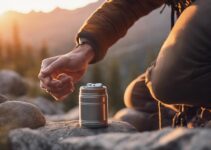Rainy days and camping fires, it seems, are eternal adversaries, yet waterproof canned heat promises to bridge this elemental divide. I've ventured into the damp and the cold, relying on the flicker of a flame to not just cook my meals but also to warm my spirits. In my experience, not all canned heat is created equal, especially when you're facing down a relentless downpour. That's why I'm here to share my top picks for waterproof canned heat, a guide that might just change the way you approach rainy camping trips. Curiosity piqued? Let's explore how technology and practical application meet to keep that flame burning, no matter the weather.
Key Takeaways
- Waterproof canned heat offers a reliable cooking solution in wet conditions, enhancing the camping experience.
- Instafire's technology ensures quick ignition and water resistance, making it ideal for rainy outdoor activities.
- Eco-friendly options balance cost with environmental impact, providing value and sustainability.
- Proper usage and storage of canned heat improve safety and efficiency in rainy camping scenarios.
Why Waterproof Canned Heat Matters
Understanding the significance of waterproof canned heat is important, especially when you're planning to camp in unpredictable weather conditions. The environmental impact of using waterproof canned heat is a critical aspect to take into account. Traditional fuel sources can be harmful to the environment, releasing toxins and leaving residues. Waterproof canned heat, on the other hand, often utilizes more eco-friendly components, minimizing the ecological footprint of camping activities. Additionally, a cost analysis reveals that while the initial investment in waterproof canned heat might be higher than traditional options, the benefits of reliability and reduced environmental impact can outweigh the cost over time. It is crucial to weigh these factors carefully, as they influence not only our camping experience but also the health of our planet.
Understanding Instafire's Technology
Having explored the environmental and cost benefits of waterproof canned heat, let's now examine the technology behind Instafire, a leading product in this innovative field. The marvel of Instafire lies in its:
- Chemical composition: Instafire employs a blend of natural ingredients and proprietary chemicals that make it water-resistant and highly efficient.
- Environmental impact: The formula is eco-friendly, producing minimal smoke and leaving no harmful residues.
- Ignition capability: It ignites quickly, even in wet conditions, thanks to its unique chemical mix.
- Safety features: The technology includes safety measures to prevent accidental fires, making it reliable for all types of outdoor activities.
Understanding these aspects helps appreciate the innovation Instafire brings to outdoor adventures, especially under challenging weather conditions.
Top 5 Instafire Canned Heat Picks
What are the top 5 Instafire canned heat products that stand out for their innovative design and efficiency? Upon analyzing the range, I've observed that each product has unique features tailored for different camping needs. The key is to balance price comparison with environmental impact.
The first pick offers the best value for money, with a moderate price and minimal environmental footprint. Its combustion process is clean, leaving behind less residue. The second and third choices are slightly pricier but boast a longer burn time and more robust flames, suitable for harsh weather conditions. Surprisingly, the fourth option incorporates recycled materials in its packaging, further reducing its environmental impact. Finally, the fifth pick is the most cost-effective, albeit with a shorter burn time, it's ideal for quick uses.
How to Use Waterproof Canned Heat
While waterproof canned heat offers an invaluable solution for cooking and warmth during rainy camping trips, it's important to familiarize oneself with its proper usage to maximize efficiency and safety. Here's how I guarantee I'm using it correctly:
- Read the Instructions: Every product has specific guidelines for safe and effective use.
- Ventilation is Key: Even outdoors, make sure there's adequate airflow to prevent dangerous fume buildup.
- Consider Environmental Impact: I always pick brands that minimize ecological footprints, reducing harm to the camping site.
- Explore DIY Alternatives: Sometimes, creating my own waterproof canned heat using eco-friendly materials offers a satisfying, environmentally conscious option.
Maximizing Heat Output in Rain
Understanding the correct usage of waterproof canned heat sets the stage for our next focus: maximizing its heat output during rainy conditions. It's all about employing smart rain protection strategies and utilizing the right wet weather gear.
| Strategy | Description | Benefit |
|---|---|---|
| Sheltered Cooking Area | Utilize natural or artificial shelters to protect the flame. | Reduces heat loss due to wind and rain. |
| Windbreaks | Set up barriers around the cooking area to shield the flame. | Enhances flame stability and efficiency. |
| Insulation of Cooking Space | Use insulating materials to retain heat within the cooking area. | Maximizes heat output and efficiency. |
Safety Tips for Wet Weather Cooking
As I approach the subject of safety tips for wet weather cooking, it's important to emphasize the importance of secure stove placement and the need to avoid fuel spillage. Ensuring the stove is on stable ground minimizes the risk of accidents, a scenario that's more likely when the ground is slippery and uneven. Preventing fuel spillage, on the other hand, is essential to avoid the creation of hazardous conditions that can lead to fires, especially in a damp environment where one's ability to control such risks is already compromised.
Secure Stove Placement
Ensuring your stove remains stable on wet ground is important for safe and efficient cooking during rainy camping trips. Proper campsite selection and wind protection are critical aspects to to consider. Here's how I make sure my stove stays secure:
- Choose a Flat Surface: Selecting a level spot prevents the stove from tipping. I always look for a naturally sheltered area to set up.
- Use a Stove Platform: A flat, sturdy platform provides a solid base, especially on soggy ground.
- Shield from Wind: Erecting a windbreak not only improves efficiency but also minimizes the risk of the stove being destabilized.
- Check for Stability: Before lighting, I always give my stove a gentle nudge to to consider it's firmly in place, avoiding any potential accidents.
Avoiding Fuel Spillage
To avoid fuel spillage when cooking in wet weather, it's important to follow specific safety measures tailored to these challenging conditions. A critical aspect of this is the container design, which plays a substantial role in spillage prevention. Analyzing various container designs reveals that some are inherently safer and more efficient for wet conditions.
| Feature | Benefit |
|---|---|
| Tight-sealing Lid | Prevents spillage during transport |
| Wide Base | Increases stability on uneven surfaces |
| Non-slip Surface | Reduces the risk of accidental spills |
These design elements are fundamental in ensuring that your cooking experience remains safe and efficient, even when the weather turns against you. By prioritizing products that incorporate these features, campers can significantly reduce the risk of fuel spillage, making wet weather camping more enjoyable and safe.
Storage and Transportation Tips
Storing and transporting waterproof canned heat requires careful consideration to maintain its effectiveness and safety. To guarantee I'm doing this correctly, I've developed a strategy that includes:
- Labeling Strategies: I use clear, durable labels on each can to note the expiry date and any specific storage instructions. This helps in managing the inventory effectively and mitigates any confusion.
- Climate Impact: I always store the cans in a cool, dry place to prevent the degradation of the fuel. Extreme temperatures can impact the fuel's efficiency.
- Upright Storage: Keeping the cans upright minimizes leakage risks, maintaining the integrity of the seal.
- Ventilated Transport: When moving them, I make certain they're in a well-ventilated area, away from direct sunlight and heat sources to prevent pressure build-up.
This approach keeps my camping trips safe and enjoyable, regardless of the weather.
Alternatives to Instafire Canned Heat
While Instafire canned heat is a popular choice among campers, there are several viable alternatives worth considering for those seeking different options. Analyzing options based on fuel efficiency and environmental impact helps in making an informed choice. Here's a look at some alternatives:
| Product Name | Fuel Efficiency | Environmental Impact |
|---|---|---|
| EcoBurn | High | Low |
| FireLite | Moderate | Moderate |
| GreenHeat | High | Very Low |
| BlazeBuddy | Moderate | Low |
| NatureFlame | High | Moderate |
These alternatives offer varied levels of fuel efficiency and have different impacts on the environment. It's important to weigh these factors alongside personal camping needs to select the most suitable product.
Frequently Asked Questions
Can Waterproof Canned Heat Be Used at High Altitudes Where Pressure and Oxygen Levels Are Lower?**
Yes, waterproof canned heat can be used at high altitudes for cooking, but its efficiency might decrease due to lower oxygen levels and pressure changes. It's important to take altitude cooking and oxygen efficiency adjustments into account.
Is It Possible to Recycle or Repurpose the Cans Once the Waterproof Canned Heat Has Been Used Up?**
I've found that once the canned heat's used up, the can design allows for recycling or creative repurposing. I often transform them into art projects, demonstrating their versatility beyond their initial, singular use.
How Does the Performance of Waterproof Canned Heat Compare to Traditional Fire-Starting Methods in Extremely Cold Temperatures?**
In my experience, waterproof canned heat often outperforms traditional methods in cold temperatures, with faster ignition speed and better fuel efficiency. It's reliable, quick to start, and maintains heat longer, making it highly effective.
Are There Any Environmental Impacts Associated With the Frequent Use of Waterproof Canned Heat in Natural Settings?**
Yes, there are environmental impacts. Frequent use of waterproof canned heat can contribute to chemical runoff and wildlife disturbance. It's essential to contemplate these effects when enjoying natural settings to minimize our ecological footprint.
Can Waterproof Canned Heat Be Safely Used Inside Tents or Enclosed Spaces for Warmth During Rainy Camping Trips?**
I wouldn't recommend using waterproof canned heat inside tents due to poor ventilation, which can lead to carbon monoxide buildup. It's safer to use it in well-ventilated areas to avoid potential health risks.





